I see several issues with your code:
You're mixing the object-oriented interface to turtle with
the functional interface to that module. I recommend one or the
other, but not both. See my import change to force OOP-only.
You're using low level tkinter mouse and key events instead of
turtle's own events. I recommend you try to work at the turtle level
(though this introduces a glitch compared to your implementation, see
below.)
You're introducing unintended recursion by not turning off events
inside your event handlers. Disabling events inside those handlers
that take significant time will clean up your graphics.
Here's my rework of your code along the above lines. The one glitch is that unlike your original, the "move turtle here" and "start dragging" will take two clicks, one screen click to move the turtle to the current location and one turtle click to start dragging. This is due to differences in the interface that turtle provides to tkinter events. (Python 3 is a little better in this regard but not for this situation.)
To ease that, I used a larger turtle cursor. I also added heading logic:
from turtle import Turtle, Screen, mainloop
WIDTH = 600
HEIGHT = 300
def gothere(x, y):
screen.onscreenclick(gothere) # disable events inside handler
turtle.penup()
print("gothere (%d,%d)" % (x, y))
turtle.goto(x, y)
turtle.pendown()
screen.onscreenclick(gothere)
def movearound(x, y):
turtle.ondrag(None) # disable events inside handler
turtle.setheading(turtle.towards(x, y))
print("movearound (%d,%d)" % (x, y))
turtle.goto(x, y)
turtle.ondrag(movearound)
def release(x, y):
print("release (%d,%d)" % (x, y))
turtle.penup()
def reset():
print("reset")
turtle.clear()
screen = Screen()
screen.setup(WIDTH, HEIGHT)
# screen.setworldcoordinates(0, HEIGHT, WIDTH, 0) # should work fine either way
turtle = Turtle('turtle')
turtle.speed('fastest')
turtle.ondrag(movearound)
turtle.onrelease(release)
screen.onscreenclick(gothere)
screen.onkey(reset, "Escape")
screen.listen()
mainloop() # normally screen.mainloop() but not in Python 2
But also see this answer where I show how to make tkinter's onmove event available to turtle.
... the "move here" then "start drag" limitation is very not
comfortable for user? How can we improve that?
Combining my above code with my alternate answer that I linked to, we get this solution that is similar to where you started but without the glitches and in a more turtle-like style:
from turtle import Turtle, Screen, mainloop
from functools import partial
WIDTH = 600
HEIGHT = 300
VERBOSE = False
def onscreenmove(self, fun, btn=1, add=None): # method missing from turtle.py
if fun is None:
self.cv.unbind('<Button%s-Motion>' % btn)
else:
def eventfun(event):
fun(self.cv.canvasx(event.x) / self.xscale, -self.cv.canvasy(event.y) / self.yscale)
self.cv.bind('<Button%s-Motion>' % btn, eventfun, add)
def onscreenrelease(self, fun, btn=1, add=None): # method missing from turtle.py
if fun is None:
self.cv.unbind("<Button%s-ButtonRelease>" % btn)
else:
def eventfun(event):
fun(self.cv.canvasx(event.x) / self.xscale, -self.cv.canvasy(event.y) / self.yscale)
self.cv.bind("<Button%s-ButtonRelease>" % btn, eventfun, add)
def gothere(x, y):
if VERBOSE:
print("gothere (%d,%d)" % (x, y))
turtle.penup()
turtle.goto(x, y)
turtle.pendown()
def movearound(x, y):
screen.onscreenmove(None) # disable events inside handler
if VERBOSE:
print("movearound (%d,%d)" % (x, y))
turtle.setheading(turtle.towards(x, y))
turtle.goto(x, y)
screen.onscreenmove(movearound) # reenable events
def release(x, y):
if VERBOSE:
print("release (%d,%d)" % (x, y))
turtle.penup()
def reset():
if VERBOSE:
print("reset")
turtle.clear()
screen = Screen()
screen.setup(WIDTH, HEIGHT)
screen.onscreenrelease = partial(onscreenrelease, screen) # install missing methods
screen.onscreenmove = partial(onscreenmove, screen)
turtle = Turtle('turtle')
turtle.speed('fastest')
screen.onscreenclick(gothere)
screen.onscreenrelease(release)
screen.onscreenmove(movearound)
screen.onkey(reset, "Escape")
screen.listen()
mainloop() # normally screen.mainloop() but not in Python 2

